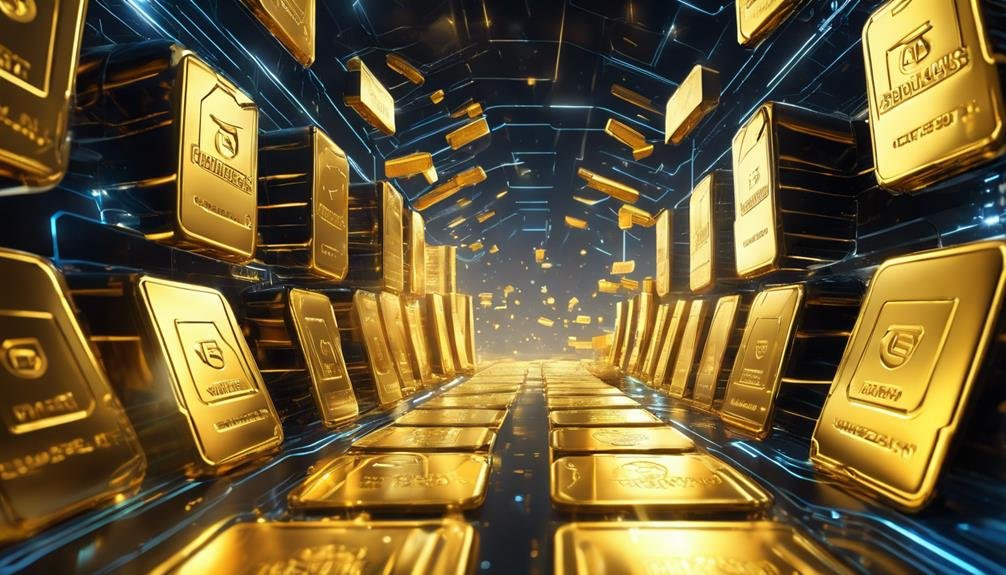Digital assets on blockchain showcase various forms that exemplify technological advancement in ownership and exchange. First, cryptocurrencies serve as decentralized mediums of exchange. Second, tokenized securities democratize investment opportunities. Third, non-fungible tokens (NFTs) represent unique digital items, with diverse applications in art and gaming. Fourth, decentralized finance (DeFi) assets facilitate peer-to-peer transactions for enhanced accessibility. Fifth, tokenized commodities represent physical assets like gold. Sixth, intellectual property tokens allow secure management of IP rights. Seventh, tokenized real estate enables fractional ownership of properties. Ultimately, carbon credits streamline trading for sustainability. Explore these examples further to uncover their implications in today’s economy.
Table of Contents
Brief Overview of 8 Example Of Digital Asset Of Blockchain
- Cryptocurrencies serve as a medium of exchange, enabling secure transactions without intermediaries on a decentralized ledger.
- Tokenized Securities represent traditional investments digitally, allowing for 24/7 trading and enhanced liquidity through fractional ownership.
- Non-Fungible Tokens (NFTs) signify unique digital items, ensuring authenticity and ownership rights in digital art, gaming, and real estate.
- Decentralized Finance (DeFi) Assets facilitate financial services without intermediaries, promoting accessibility and transparency in transactions.
- Tokenized Real Estate enables fractional ownership of properties, lowering investment barriers and increasing liquidity for real estate assets.
Introduction
As digital assets have gained popularity in recent years, blockchain technology has emerged as the backbone for their creation, management, and trading. This innovative technology provides a secure, decentralized platform for various types of digital assets, enabling you to track ownership and transfer rights seamlessly.
The rise of cryptocurrencies like Bitcoin and Ethereum illustrates how blockchain facilitates peer-to-peer transactions, eliminating the need for intermediaries and reducing costs. Additionally, the implementation of cryptographic security guarantees that transactions remain protected against fraud and unauthorized access.
Moreover, blockchain technology has revolutionized the concept of digital collectibles, often represented as Non-Fungible Tokens (NFTs). These unique digital assets allow creators to tokenize their work, guaranteeing authenticity and provenance through an immutable ledger. This transparency attracts collectors who value distinct items, knowing their ownership can’t be disputed.
Tokenized real estate is another exciting application of blockchain technology. By converting physical properties into digital assets, you can invest in fractions of real estate, making it accessible to a broader audience.
This innovation not only democratizes investment opportunities but also streamlines property transactions, reducing paperwork and increasing efficiency.
What Is a Digital Asset on Blockchain?
Digital assets on blockchain are unique items that you can own and exchange, like Non-Fungible Tokens (NFTs) representing art or collectibles.
They leverage blockchain technology to guarantee transparency, security, and accessibility, making it easy to verify ownership and authenticity.
Understanding their importance in the blockchain ecosystem highlights how these assets contribute to a new digital economy.
Importance of Digital Assets in the Blockchain Ecosystem
In today’s digital landscape, understanding the importance of digital assets on the blockchain is essential for anyone interested in the future of technology and finance. Digital assets serve as the backbone of the blockchain ecosystem, promoting decentralization, ownership, and liquidity. Here’s why they matter:
- Decentralization: Blockchain digital assets eliminate the need for intermediaries, allowing users to transact directly. This fosters a more inclusive financial system where individuals retain control over their assets.
- Ownership: With blockchain tokenization, you can prove ownership of various digital assets, such as tokenized securities or NFTs. This transparency guarantees authenticity, critical for creators and collectors alike.
- Liquidity: Digital asset trading enables swift conversions of various assets, including DeFi assets, into cash or other cryptocurrencies. This ease of access enhances market dynamics and encourages investment.
The integration of digital assets into everyday transactions signifies a shift in how you perceive value and ownership.
As the blockchain ecosystem continues to evolve, understanding these elements will be key to steering the future of finance and technology successfully.
1. Cryptocurrencies

Cryptocurrencies are a revolutionary type of digital asset that leverage cryptography and blockchain technology to facilitate secure transactions. These blockchain digital assets enable you to send and receive funds without the need for intermediaries like banks. Instead, transactions are recorded on a decentralized ledger, ensuring transparency and security. Popular examples include Bitcoin and Ethereum, both of which have gained significant traction in the financial ecosystem.
Unlike NFTs, which represent ownership of unique digital items, cryptocurrencies function as a medium of exchange. They can be subdivided, making them versatile for various transaction sizes. Blockchain tokens, like those used in decentralized finance (DeFi) applications, further enhance this capability by allowing users to lend, borrow, and earn interest on their cryptocurrencies without traditional financial institutions.
One of the key advantages of cryptocurrencies is their potential for financial inclusion. With just an internet connection, anyone can access these blockchain digital assets, breaking barriers often imposed by conventional banking systems. This accessibility is a core component of the decentralized finance movement, which aims to create an open financial system that operates globally without centralized control.
As you explore the world of cryptocurrencies, you’ll discover a range of opportunities and risks. Understanding the underlying technology and market dynamics is essential for maneuvering this evolving landscape. By recognizing the role of cryptocurrencies as digital assets, you can better appreciate their impact on finance and technology today.
2. Tokenized Securities
While traditional securities like stocks and bonds have long been the backbone of investment portfolios, tokenized securities are transforming how you can engage with these assets.
These blockchain-based assets provide a digital representation of conventional securities, making them accessible in a way that was previously unimaginable. With the rise of the digital asset marketplace, tokenized securities offer several advantages that traditional investments often lack.
Here are three key benefits of tokenized securities:
- Liquidity: Tokenized securities can be traded 24/7 on various platforms, enhancing liquidity compared to conventional markets. This means you can buy or sell your assets at any time, providing greater flexibility.
- Fractional Ownership: With blockchain tokens, you can own a portion of a security rather than needing to purchase a whole share. This democratizes investment opportunities, allowing you to diversify your portfolio without significant capital.
- Transparency and Security: Since tokenized securities are recorded on a blockchain, all transactions are transparent and immutable. This guarantees a higher level of security and reduces the risk of fraud, giving you confidence in your investments.
As you explore tokenized securities, you’ll find they represent a significant evolution in how investments can be structured and traded.
3. Non-Fungible Tokens (NFTs)

Non-Fungible Tokens (NFTs) are revolutionizing the way we think about digital ownership. Unlike cryptocurrencies, which are interchangeable, NFTs represent unique digital items, making them invaluable in the domain of Digital Collectibles. By utilizing a Blockchain NFT, each token is stored on a decentralized ledger, ensuring authenticity and provenance. This technology underpins various applications, from digital art to gaming assets, allowing creators and collectors to establish ownership of distinct digital assets.
The rise of NFT marketplaces, such as OpenSea and Rarible, has transformed how you buy, sell, and trade these digital assets. Notable examples like CryptoPunks and Bored Ape Yacht Club have garnered massive attention, demonstrating the potential of NFTs to create vibrant communities around unique digital goods. You can own a piece of digital art, a virtual pet, or even limited-edition game items, all secured by blockchain technology.
Moreover, NFTs extend beyond art and collectibles into fields like blockchain real estate and intellectual property blockchain. Imagine owning a virtual piece of land or having a digital copyright to an innovative idea—all verifiable through NFTs. This level of ownership adds a new dimension to how you can interact with digital content, providing rights that were previously difficult to enforce.
4. Decentralized Finance (DeFi) Assets
Decentralized Finance (DeFi) assets are shaking up traditional financial systems by offering innovative solutions like lending tokens, liquidity provider tokens, and staking tokens within blockchain ecosystems.
These assets allow users to engage with financial services without intermediaries, creating a more accessible and open financial landscape. Through DeFi, you can participate in yield farming and improve capital efficiency, while benefiting from increased transparency and lower fees.
Here are three key types of DeFi assets you should know about:
- Lending Tokens: These allow you to lend your crypto assets to other users, earning interest on your holdings. It’s a way to put your assets to work while maintaining ownership.
- Liquidity Provider Tokens: When you add liquidity to a decentralized exchange, you receive these tokens in return. They represent your share of the liquidity pool and can earn you trading fees based on transaction volume.
- Staking Tokens: By locking up your tokens in a network, you help secure it and, in return, receive rewards. This not only supports the network but also provides an opportunity for passive income.
As DeFi assets continue to evolve, they’re also exploring areas like blockchain for sustainability, integrating environmental assets into financial systems.
In this way, DeFi isn’t just about financial innovation; it’s also about creating a more sustainable future through tokenized commodities that support eco-friendly practices.
5. Tokenized Commodities

Tokenized commodities are revolutionizing the way we trade traditional assets like gold and oil by leveraging blockchain technology. When you tokenize a commodity, you create a digital representation of it on a blockchain, allowing for easier trading and ownership verification. This process transforms physical assets into blockchain commodity assets, making them more accessible and efficient to trade.
One significant advantage of tokenized commodities is the ease of trade. By utilizing smart contracts on a blockchain, you can execute transactions automatically, reducing the time and costs usually associated with traditional trading methods.
Plus, blockchain security guarantees that your transactions are safe, transparent, and immutable, giving you confidence in your trades.
Global market access is another essential benefit. Tokenized commodities can be traded anytime and anywhere, breaking down geographical barriers. This accessibility allows a broader range of investors to participate in the market, increasing liquidity and driving down costs.
Furthermore, tokenization extends beyond conventional commodities like gold and oil to include assets such as carbon credits, creating additional opportunities for sustainable investing.
6. Intellectual Property (IP) Tokens
Intellectual property rights can be securely managed and traced on the blockchain, offering a revolutionary way to protect patents, trademarks, and creative works. By utilizing IP tokens, creators can tokenize their intellectual property, transforming it into digital assets that are easily transferable and verifiable on a blockchain. This guarantees authenticity and ownership, greatly reducing piracy and infringement issues.
Here are three key benefits of using IP tokens:
- Traceability: Blockchain’s immutable ledger allows for the precise tracking of ownership and transaction history, providing clear proof of who owns what.
- Accessibility: Artists and inventors can sell or license their work directly to consumers without intermediaries, maximizing their profits and minimizing potential losses.
- Global Reach: IP tokens can be traded or licensed across borders, granting creators access to a worldwide market.
Examples of how IP tokens are used can be seen in industries like music and art. Musicians can issue tokens representing ownership shares of their songs, allowing fans to invest in their favorite artists while guaranteeing that revenue is fairly distributed.
Similarly, artists can create NFTs to represent their artwork, ensuring that buyers receive verified ownership of unique pieces, thereby becoming part of the 8 examples of digital assets of blockchain.
In the domain of blockchain DeFi, IP tokens exemplify how digital assets can revolutionize traditional industries, making them more efficient and transparent. By leveraging technology, you help pave the way for a new era in intellectual property management.
7. Tokenized Real Estate

Investors are increasingly turning to tokenized real estate as a way to diversify their portfolios and access lucrative property markets. By leveraging blockchain technology, real estate properties can be divided into digital tokens, allowing you to own fractions of these assets. This fractional ownership model makes it easier for you to invest in high-value properties that may have previously been out of reach.
One of the primary benefits of tokenized real estate is liquidity. Traditionally, selling real estate can be a lengthy process, involving significant paperwork and potential delays. However, with tokenized properties, you can buy and sell your tokens on blockchain platforms, enhancing the speed and ease of transactions. This increased liquidity can lead to a more dynamic market, where you can adjust your investments based on current trends.
Additionally, tokenized real estate reduces barriers to entry. You no longer need substantial capital to invest in real estate; instead, you can purchase a fraction of a property at a lower price. This democratizes access to real estate investments, allowing a broader range of investors to participate in property markets.
As a result, you can diversify your investment portfolio more effectively, spreading risk across various properties and markets.
8. Carbon Credits and Environmental Assets
Carbon credits and other environmental assets are gaining traction as crucial tools in the fight against climate change. By tokenizing these assets on blockchain platforms, you can enhance transparency and efficiency in trading, making it easier for organizations and individuals to participate in sustainability efforts.
Tokenization allows carbon credits to be tracked and traded securely, ensuring that each transaction is transparent and verifiable.
Here are three significant benefits of using blockchain for carbon credits and environmental assets:
- Transparency: Blockchain technology provides an immutable ledger, ensuring that all transactions are recorded and accessible. This transparency helps build trust among participants, making it easier to verify the authenticity of carbon credits.
- Efficiency: Blockchain streamlines the process of buying and selling carbon credits, reducing the administrative burden and transaction costs associated with traditional systems. This efficiency encourages more entities to engage in carbon trading.
- Global Participation: By utilizing blockchain, carbon credits can be traded globally, allowing a wider range of participants to contribute to environmental initiatives. This inclusivity can amplify the impact of sustainability efforts across different regions.
Projects like KlimaDAO and CarbonX illustrate the potential of blockchain in promoting environmental assets. These initiatives aim to create robust marketplaces for carbon credits, incentivizing businesses to reduce their carbon footprints.
As the demand for sustainable practices increases, the role of blockchain in environmental assets will likely expand, making it a crucial component of the climate change solution.
How Digital Assets Are Changing Global Markets

Digital assets like NFTs are reshaping how you view ownership and value in various sectors.
As these assets gain traction, you’ll notice traditional markets adapting to new technologies, which could redefine transactions in finance, real estate, and art.
Future trends suggest that innovation in digital assets will continue to blur the lines between physical and virtual economies, creating unique opportunities and challenges for investors and creators alike.
Future Trends in Digital Asset Development
The landscape of global markets is on the brink of transformation as digital assets gain traction across various sectors. As you explore the future potential of digital assets, you’ll notice emerging trends that are reshaping the financial landscape.
Tokenization, decentralized finance (DeFi), and non-fungible tokens (NFTs) are at the forefront of this evolution.
- Tokenization: Assets, ranging from real estate to intellectual property, are becoming tradable on blockchain platforms. This allows fractional ownership, making investments more accessible than ever.
- DeFi: Decentralized finance is revolutionizing traditional banking by offering services such as lending and trading without intermediaries. You’ll see a growing number of platforms enabling peer-to-peer transactions, increasing financial inclusion.
- NFTs: While NFTs initially gained fame in the art world, their utility is expanding. Expect to see NFTs representing ownership in various sectors, including gaming and music, further establishing digital ownership and provenance.
These trends suggest that digital assets aren’t just a passing fad; they’re poised to redefine how you engage with markets, invest, and own unique digital properties in the coming years.
Conclusion
Many enthusiasts and innovators recognize the profound significance of digital assets on the blockchain. These assets, like Non-Fungible Tokens (NFTs), are reshaping the way we perceive ownership and value in the digital domain. By utilizing blockchain technology, digital assets offer a transparent, immutable ledger that guarantees authenticity and provenance. This evolution isn’t just for artists and collectors; it’s influencing industries across the board.
To understand the impact of blockchain digital assets, consider the following table:
| Type of Digital Asset | Significance |
|---|---|
| NFTs | Unique ownership of digital items |
| Cryptocurrencies | Decentralized finance and transactions |
| Smart Contracts | Automated agreements and processes |
As you explore the various types of digital assets, you’ll see how they interact with the global economy. The rise of blockchain technology is paving the way for new business models, enhancing security, and reducing transaction costs. It’s essential to grasp these concepts, as they represent a fundamental shift in how we conduct business and trade.
Frequently Asked Questions
What Is a Digital Asset in Blockchain?
A digital asset in blockchain refers to any item of value digitally encoded and secured through blockchain technology.
These assets include cryptocurrencies, tokens, and Non-Fungible Tokens (NFTs). Each asset has a unique identifier stored on the blockchain, ensuring transparent ownership and authenticity.
The immutability of blockchain records prevents tampering, making digital assets reliable.
Additionally, they can be fractionalized, allowing multiple individuals to own parts of valuable assets, thereby broadening investment opportunities.
What Are Examples of Digital Assets?
When considering examples of digital assets, you’ll encounter various forms.
Cryptocurrencies like Bitcoin and Ethereum serve as decentralized currencies. Non-Fungible Tokens (NFTs) represent unique digital items, ensuring ownership and authenticity.
Additionally, tokenized securities digitize traditional financial instruments, improving liquidity. You might also find tokenized real estate, which enables fractional ownership of properties, making investments more accessible.
Ultimately, stablecoins offer a stable option for transactions amid cryptocurrency volatility, enhancing market stability and participation.
What Are Some Examples of the Blockchain?
You’ll find various examples of blockchain technology in action.
Cryptocurrencies like Bitcoin and Ethereum enable secure transactions without intermediaries.
Decentralized Finance (DeFi) platforms offer services such as lending and trading, operating independently from traditional banks.
Additionally, Central Bank Digital Currencies (CBDCs) are emerging, utilizing blockchain to create government-backed digital currencies.
Each application showcases blockchain’s potential to enhance transparency, security, and efficiency across multiple industries, transforming how we conduct financial and digital transactions.
Is Ethereum Considered a Digital Asset?
Yes, Ethereum is considered a digital asset. It functions as a decentralized blockchain platform, enabling the creation of various tokenized assets, including cryptocurrencies and non-fungible tokens (NFTs).
Its market capitalization exceeds $200 billion, making it the second-largest cryptocurrency. Ethereum’s smart contracts facilitate transactions, while its recent upgrade to proof-of-stake enhances scalability and sustainability.
This positions Ethereum as an essential component in the blockchain ecosystem, appealing to both developers and investors alike.
Summarizing
Digital assets on the blockchain are reshaping ownership and value in unprecedented ways. From cryptocurrencies to NFTs and tokenized securities, these assets enhance transparency and security in transactions. They also democratize access to investment opportunities while fostering innovation across industries. As global markets adapt to these changes, understanding the implications of digital assets becomes essential. Your awareness of these developments positions you to engage with future economic landscapes, where digital ownership will play a critical role.




